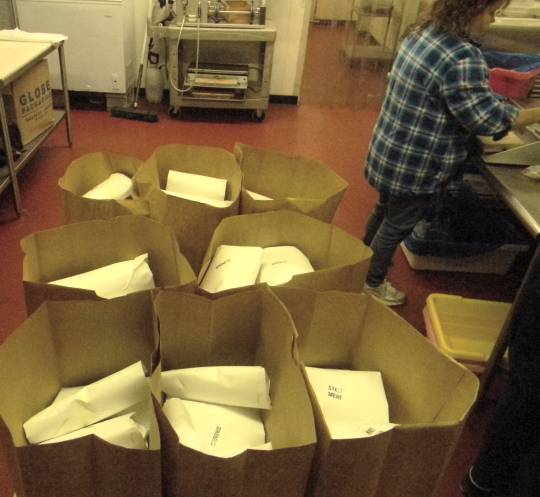 The final product: After being wrapped, the venison gets bagged before it is frozen at Austin's Deer Processing in Hanover, Maryland, on Wednesday, Nov. 7, 2018. (Photo by Chris Tulp)
The final product: After being wrapped, the venison gets bagged before it is frozen at Austin's Deer Processing in Hanover, Maryland, on Wednesday, Nov. 7, 2018. (Photo by Chris Tulp)ANNAPOLIS (November 29, 2018)—Some Maryland deer hunters now can claim a credit against their state income taxes for donating their processed venison to the hungry.
A new law allows hunters to receive a $50 tax credit for each antlerless deer they harvest and pay to have butchered. The maximum credit hunters may claim in one tax year is $200, for up to four antlerless deer.
The expenses of butchering and processing the deer will be offset by this tax credit as long as the venison gets donated to an organization that helps provide meals for those who are hungry and less fortunate.
Participating butchers charge $60-$65 to butcher one deer, according to Josh Wilson, executive director of Farmers and Hunters Feeding the Hungry, a group that has used donations and grants to pay butchers to prepare venison slated for donation.
The group has seen its funds wither in recent years, and the law—new this hunting season—is intended to offset that decline.
Until the funds the group allocates to a particular butcher run out, Farmers and Hunters Feeding the Hungry pays the bill.
This is a discounted rate of around 20 percent off the normal price of about $80 for having a deer processed.
After the funds are depleted, hunters would have to pay the processing bill directly to the butcher and ask for—and save—their paid receipt. They may then claim the $50 credit when filing their Maryland income taxes.
Farmers and Hunters Feeding the Hungry is a non-profit organization founded in 1997 by former teacher Rick Wilson (Josh Wilson's father) as a ministry of his Lutheran church in Hagerstown, Maryland.
Farmers and Hunters Feeding the Hungry has expanded to over 25 states with more than 130 coordinators working to help feed the needy.
Since 1997, the group has paid to process over 2 million pounds of venison donated by hunters in Maryland, according to Josh Wilson. The donations have provided meat for more than 8 million meals to the hungry through relief organizations in the state, according to Wilson.
"The hunter brings the deer in and we skin it and cut it," said Kristin Trossback, owner of Austin's Deer Processing in Hanover, Maryland. "We then freeze the meat to be picked up by the Anne Arundel County Food Bank."
The venison goes to soup kitchens and food pantries throughout Anne Arundel County, according to Marta Jones, volunteer coordinator at the food bank.
"We allocate a specific number of deer to each butcher shop that we can afford to pay them for processing based on the funding we have available in our program budget from contributions and fundraisers in their area," said Wilson.
As those grants have waned, lawmakers have tried to make up the difference with the tax write-off.
The tax credit applies to bow and arrow (Sept. 7 through Jan. 31), muzzleloader (Oct. 18 through Dec. 29) and firearms (Nov. 24 through Dec. 8) seasons.
The law went into effect on July 1 after it was sponsored by Delegate Johnny Mautz, R-Caroline, Dorchester, Talbot and Wicomico, and signed on April 24 by Gov. Larry Hogan. Hogan is a member of the Governors Sportsmen's Caucus while Mautz is a member of the Maryland Legislative Sportsmen's Caucus.
"The tax credit came about from a lawmaker's (Mautz's) concern that they (the grants) wouldn't be able to support the group"—Farmers and Hunters Feeding the Hungry—said Paul Peditto, wildlife and heritage service director for the Maryland Department of Natural Resources. "It is a reasonable way to incentivize hunters and farmers to donate venison to help those who are hungry."
"We couldn't use revenues from hunting licenses to fund"—Farmers and Hunters Feeding the Hungry—Mautz told Capital News Service. "The only option left was to go to Gov. Hogan to ask for funds."
According to Farmers and Hunters Feeding the Hungry, food banks informed them that meat is the least available food item due to the high costs, so they gratefully accept these venison donations.
Venison is a meat that is high in protein and low in fat and it is given to places such as church pantries, church feeding ministries, the Salvation Army, community food banks, emergency assistance programs, rescue missions and children's homes—where it is distributed and served.
"Certain places where we can donate the venison are given to us by" Farmers and Hunters Feeding the Hungry, said Gregory Jackson, owner of Harwood Butcher Shop, in Anne Arundel County. "It's usually one or two local food banks or organizations close to where we're located."
"The meat is all picked up directly from the butchers by these local food banks, ministries and relief organizations for use in their feeding program," said Wilson. "They are already in place to handle distribution, so we (Farmers and Hunters Feeding the Hungry) just provide the meat to them to add to their inventory."
In the past, Farmers and Hunters Feeding the Hungry received significant amounts of grant funding from various places, including the Maryland Department of Natural Resources, the Maryland Grain Producers Utilization Board, Maryland Soybean Board, Cabela's Outdoor Fund and the Walmart Foundation, but most of these are no longer available due to budget cuts, so they rely almost entirely on individual donors and supporters, according to Wilson.
"We have received several community grants from the Walmart Foundation through two local Walmart and Sam's Club stores this year in Frederick and Wicomico Counties," said Wilson. "Those grants typically start at around $500 and can go as high as several thousand dollars."
However, the statewide Walmart Foundation Grant is larger, as it was worth $50,000 last year, but this year, Farmers and Hunters Feeding the Hungry has no grants from them anymore, or any other statewide grants.
"Their state giving program changed this year to an invitation-only process," said Wilson. "They selected a number of charities from some key areas of the country to submit requests."
Farmers and Hunters Feeding the Hungry reached a high point during the fiscal year of the 2013 hunting season with total revenue from grants and donors totaling just under $382,000.
"That year included significant grants from Maryland Department of Natural Resources, the Maryland Soybean Board and the Maryland Grain Producers and Utilization Board," said Wilson. "For the current fiscal year, we are projecting total revenue of around $121,000 with zero grant funding from those sources."
Farmers and Hunters Feeding the Hungry is not federally funded, said Dave McMullen, an Anne Arundel County volunteer coordinator for the group. "If each hunter donated $3 to $5, this would cover funding needs. When the funding is there, the program has the ability to expand."
McMullen continued, "All hunters and the public should know that the more money that gets donated, the more deer can be processed, and the more money can be given to local or county food banks. It's a win-win situation that takes care of the overpopulation of deer and takes care of people, providing them with high quality meat."
The Maryland Department of Natural Resources Deer Project is responsible for managing the populations of native white-tailed deer and non-native sika deer.
"Deer numbers have been stable in Maryland across most of the state for the past decade," said Brian Eyler, deer project leader of the wildlife and heritage service for the Maryland Department of Natural Resources. "That being said, there are still issues with too many deer in many of our urban and suburban areas. There are currently approximately 225,000 deer in Maryland."
Hunting remains the most cost-effective and efficient population-control mechanism available in most Maryland landscapes, according to the Maryland Department of Natural Resources.
According to a legislative summary, state general fund revenues are expected to decrease by an estimated $50,000 annually in fiscal year 2019 through fiscal year 2023 as a result of credits claimed against personal income taxes.
The Maryland comptroller's office reported that it will incur a cost of $54,000 to add the tax credit to returns.
Any unused amount of the tax credit can't be carried into another tax year and the program terminates June 30, 2023.


